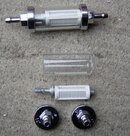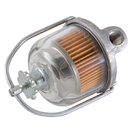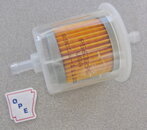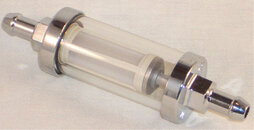I'm actually OK running it like it is right now until I get the right fuel tank. I am totally confident of how the single fore tank is set up and with the fuel pressure gauge, I can see how the filter is doing. If I see the pressure drop below 3 psi, I'll be changing that filter. Right now it runs just above 4 psi #3,500 rpm.
You are using an out of date browser. It may not display this or other websites correctly.
You should upgrade or use an alternative browser.
You should upgrade or use an alternative browser.
The MV ScubaBoard...
- Thread starter The Chairman
- Start date
Please register or login
Welcome to ScubaBoard, the world's largest scuba diving community. Registration is not required to read the forums, but we encourage you to join. Joining has its benefits and enables you to participate in the discussions.
Benefits of registering include
- Ability to post and comment on topics and discussions.
- A Free photo gallery to share your dive photos with the world.
- You can make this box go away
Peter_C
Contributor
As I understand it a Jerry can is not allowed on boats. I could be way wrong though. Came from folks buying fuel for their personal water craft and hauling it on their boats at the lake. I was told it was a no no.
As to the fuel pump, I have seen electric fuel pumps over pressure the carb seats in the past causing flooding. One had a regulator installed inline even. So far I have taken two electric pumps out and replaced them with simple reliable mechanical pumps. All problems solved. The mechanical pump only pumps what is needed as it is speed variable. One of the electric fuel pumps was a Holley super pump of some kind and has pumped hundreds of gallons for me emptying fuel tanks, in prep to remove the tanks, most often for fuel pump replacement; IE: Chevy. At least it got recycled.
The other challenge with electric pumps is making sure they are wired so if/when the engine stalls they shut off a few seconds later. This takes a relay, timer, and some additional wiring. Something few people do when installing electric pumps, but it is a huge safety factor especially in vehicles where a roll over could occur.
Fuel filters: Anything made of glass scares the crap out of me. Not because the glass will break, but because the seal can and will fail. I have seen my friends very nice Ford Cougar leave a trail of gas as he had one of those cool glass fuel filters that don't do much. It appears there is another style mounted on your boat directly under the coil. Am I seeing that correctly? Is that one gone now?
This style is the absolute worst as it is made of pot metal, and only half the threads are left on the bolt, so the gas can flow past. They fail way to often.

The one I saw below the coil looks like this? I still wouldn't trust the sealing surface.

My preference is this style.

As to the fuel pump, I have seen electric fuel pumps over pressure the carb seats in the past causing flooding. One had a regulator installed inline even. So far I have taken two electric pumps out and replaced them with simple reliable mechanical pumps. All problems solved. The mechanical pump only pumps what is needed as it is speed variable. One of the electric fuel pumps was a Holley super pump of some kind and has pumped hundreds of gallons for me emptying fuel tanks, in prep to remove the tanks, most often for fuel pump replacement; IE: Chevy. At least it got recycled.
The other challenge with electric pumps is making sure they are wired so if/when the engine stalls they shut off a few seconds later. This takes a relay, timer, and some additional wiring. Something few people do when installing electric pumps, but it is a huge safety factor especially in vehicles where a roll over could occur.
Fuel filters: Anything made of glass scares the crap out of me. Not because the glass will break, but because the seal can and will fail. I have seen my friends very nice Ford Cougar leave a trail of gas as he had one of those cool glass fuel filters that don't do much. It appears there is another style mounted on your boat directly under the coil. Am I seeing that correctly? Is that one gone now?
This style is the absolute worst as it is made of pot metal, and only half the threads are left on the bolt, so the gas can flow past. They fail way to often.

The one I saw below the coil looks like this? I still wouldn't trust the sealing surface.

My preference is this style.

Attachments
Blue Sparkle
Contributor
As I understand it a Jerry can is not allowed on boats.
That's interesting. There is hardly a cruising sailboat without at least two jerry cans aboard (because otherwise how can you get fuel to the boat when there is no fuel dock and you have to dinghy in for it, which is the case in many places?). I would be really against a law like that.
I have been at marinas where they discouraged slipholders from bringing in fuel from "outside," (land-based gas stations) vs. buying it at their fuel dock; I wonder if that's what you were experiencing?
The one in the initial photo below the coil is gone. It was OE on the boat (which is circa 1968)
I hear what you are saying about the glass fuel filter, and the only reason I really like it is that I can see what it's filtering. Your plastic example does that, so I'll go buy that filter.
I do have an oil pressure combo switch. One part turns on the low oil light, the other part only allows electricity to the fuel pump when there is more than 8 psi oil pressure. I do have a bypass switch to prime things.
I hear what you are saying about the glass fuel filter, and the only reason I really like it is that I can see what it's filtering. Your plastic example does that, so I'll go buy that filter.
I do have an oil pressure combo switch. One part turns on the low oil light, the other part only allows electricity to the fuel pump when there is more than 8 psi oil pressure. I do have a bypass switch to prime things.
Peter_C
Contributor
I clearly misunderstood. Never checked into it before since I never had a need to haul extra fuel. We have tons of marinas around our inland water ways, and offshore you should follow the rules of thirds, let alone have a big fuel tank. Maybe they were getting a lecture because they didn't take the fuel tanks out of the boat when fueling them. I see people haul extra fuel all the time. Seen a few sailboats with 20 fuel containers onboard. Hopefully it was diesel.
- When refueling portable fuel tanks, take them out of the boat and fuel them on the gas dock. And, wipe off any spills or oil before reinstalling in the boat. Before refueling built-in fuel tanks, close all doors, windows, and hatches. Following the refueling operation, open up the boat and ventilate all spaces, especially the bilges and engine compartment. Check for fumes and inspect for water, oil, and fuel leaks. If your boat has a blower, run the blower for a few minutes before starting the engine.
- Recreational boaters are generally discouraged from carrying spare fuel aboard their vessel. Although there appears to be no prohibition in the Federal boating regulations for carrying spare fuel, there are risks involved which justify avoiding the practice. If you do choose to carry spare fuel, be sure that you tranport the fuel in a container approved for that use, and in serviceable condition. The containers must be non-breakable and free of corrosion, have a vapor-tight leak-proof cap, and if vented they must be closeable vents. The container(s) must be secured in the boat in an area which is properly ventilated. Remember, filling a portable fuel tank from a spare fuel container presents an addition spill risk. The transfer should be done outside the boat and in a location where any spills will not contaminate the surrounding water or your bilge. Mishandling fuel and resulting spills can result in a citation and substantial fines, so it's wise to avoid any unnecessary fueling hazards.
Blue Sparkle
Contributor
Just a note that in my experience a jerry can is not the same as a portable fuel tank. A jerry can is more of a fuel "jug" and is not meant to supply fuel to a running engine. That said, I am not saying that jerry cans should not be used safely, especially if they contain fuel (oftentimes they are empty).
captain
Contributor
Do you plan on putting the plastic see through filter on the pressure side of the pump. I would not, personal choise but just the canister filter on the suction side of the pump and the fewest possible potential leak points on the pressure side of the pump. One continuous line from pump to carb.
Not sure if the plastic filter will pass this test and is allowed in any location if it is not USCG approved.
http://www.uscgboating.org/regulations/boatbuilder_s_handbook/fuel_standards_parth.aspx
Not sure if the plastic filter will pass this test and is allowed in any location if it is not USCG approved.
http://www.uscgboating.org/regulations/boatbuilder_s_handbook/fuel_standards_parth.aspx
Similar threads
- Replies
- 7
- Views
- 2,832
- Replies
- 2
- Views
- 703
- Replies
- 30
- Views
- 3,475
- Replies
- 75
- Views
- 6,056
- Replies
- 0
- Views
- 281




